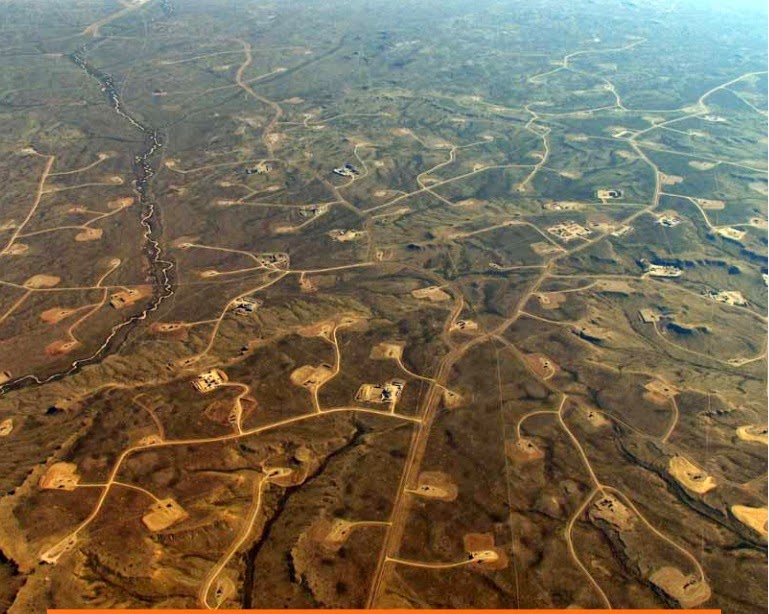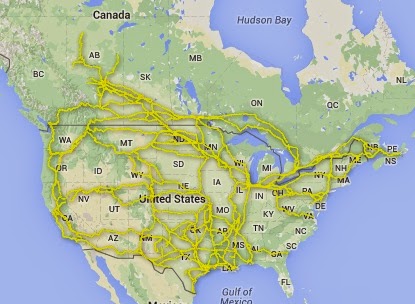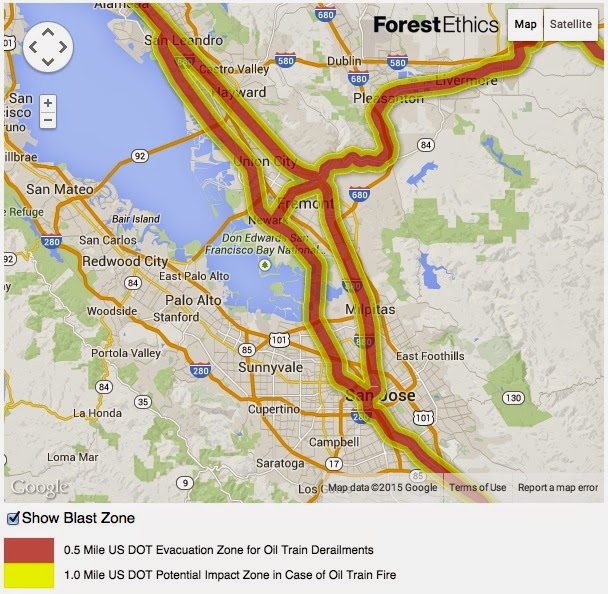A big deal is being made over approval of the Keystone XL pipeline that’s meant to carry tar sands oil from Alberta down to the Gulf Coast for refining and shipping to the global oil market. Environmental groups like 350.org are raising a stink about the project, saying that it will a “carbon bomb” because the tar sands oil is the most carbon intensive oil resource on the planet. A sideshow to that project is not other pipelines, but the other methods oil companies are using to ship oil from both Alberta and the fracking fields of North Dakota to market. Such as the mile-long oil trains hauling DOT-111 tanker cars full of crude oil.
The concern is a proposal by a Phillips Petroleum refinery in San Luis Obispo County that wishes to start importing crude oil from either the Bakken or Alberta Tar Sands, refine it, then sell it to the global oil market. Under the plan the refinery will receive 5 oil trains a week, each hauling 80 tanker cars of crude oil.You might ask, where does the SF Bay Area fit into this picture? Why do we care what San Luis Obispo County does or doesn’t do?
The issue is that those trains will travel along tracks that go through the heart of San Jose. The same tracks carry the local AMTRAK lines, some commuter rail services, and various freight trains. The route goes through other parts of the SF Bay Area, across the Central Valley, then north either through the Dunsmuir gap or the Feather River Valley. The last two are in the mountains, with Dunsmuir being just south of Mt. Shasta, and the Feather River Valley being one of the routes across the Sierra Nevada Mountains and into Nevada.
Both the Dunsmuir and Feather River rail lines have seen numerous train derailments, some of which have been serious ecological disasters. The Feather River feeds Lake Oroville, which supplies water to 25 million Californians, and contains some old creaky ancient rail infrastructure built in extremely rugged terrain. The Dunsmuir route is in a river valley feeding Lake Shasta, which itself supplies water to many Californians.
The risk – an oil train explosion in Downtown San Jose for example, or above Lake Oroville, or anywhere – begs a question – how likely is this to happen? I don’t have figures for the rate of train derailments, but I do know that shipping crude oil by train has jumped 4000% between 2008 and 2013. In 2013 there were about 10,000 rail cars of crude oil shipped by train and in 2013 it was 407,000 rail cars. With that increase in shipping oil by train, the number of oil train derailments will also increase. Further, the continued success with blocking oil pipeline projects means the oil companies can only turn to oil trains to get their product to market.It’s already been clear the oil companies will just find other ways to bring tar sands and Bakken oil to the market if the pipelines are blocked. Oil trains are just one of those methods.To give an idea of the extent of oil shipments by rail look at these maps which come from a website created by Forest Ethics – http://explosive-crude-by-rail.org/![]()
These yellow lines are train routes being used (or will be used) by oil trains. This is going EVERYWHERE .. in back yards all across America.
This is the California and Nevada exposure to the oil trains.
Then to see what the concern is about we zoom way in, and also show the legend at the bottom. The red zone is a 1/2 mile radius from the track which would see a huge exposure during any oil train accident (and therefore be subject to mandatory evacuation) while the yellow zone will have a smaller impact.
It’s not clear from the website – but these maps are probably not showing actual current oil by rail shipments, because there aren’t shipments currently occurring through the SF Bay Area. But, Forest Ethics has an inventory of proposed and approved projects that would require oil by rail shipments. Therefore these maps must be the potential extent of the proposed system.
In any case, take the map on their website and zoom around the country. You’ll see oil train routes through major metropolitan areas – downtown Chicago for instance, and elsewhere.
The meeting I attended today had the flavor of a “Not In My Back Yard” (NIMBY) outrage. The sort of meeting where a group of local citizens ban together to block a project from ruining their back yard. But the extent of these oil by rail shipments affect the backyards of tens of millions of people across the U.S. and Canada.
The problems with this are:
Continues the pattern of investment in fossil fuel resources and infrastructure – hence the continued dependence on fossil fuels
Grave effects when these trains derail and explode
The crude oil coming from the Alberta Tar Sands and the Bakken is more explosive than regular crude oil, according to a report from August 2013. Some oil processing companies are worried about the corrosive chemicals being used could damage the equipment.
Even if an oil train derailment doesn’t result in an explosion and fire, you are talking about a spill of crude oil that’s more toxic than normal. Normal crude oil is already poisonously toxic with a witches brew of carcinogenic chemicals. As we just noted, this crude oil contains even more toxicity.
The danger is amplified by the sort of rail cars being used. The DOT-111 rail cars weren’t designed for shipping crude oil, and the U.S. Dept of Transportation has been trying for yeas to get the rail industry to stop using these cars. It’s well known that in accidents the DOT-111 cars are prone to breaking, leaking, their contents, and when the contents is a highly explosive liquid fires and explosions can easily occur.
But the rail industry has refused .. because .. wait for it … it would be too expensive to switch to safer rail cars.
The whole story is another example of how our collective dependence on fossil fuels are causing immense problems.
- Highway design could decrease death and injury risk, if “we” chose smarter designs - March 28, 2015
- GM really did trademark “range anxiety”, only later to abandon that mark - March 25, 2015
- US Government releases new regulations on hydraulic fracturing, that some call “toothless” - March 20, 2015
- Tesla Motors magic pill to solve range anxiety doesn’t quite instill range confidence - March 19, 2015
- Update on Galena IL oil train – 21 cars involved, which were the supposedly safer CP1232 design - March 7, 2015
- Another oil bomb train – why are they shipping crude oil by train? – Symptoms of fossil fuel addiction - March 6, 2015
- Chevron relinquishes fracking in Romania, as part of broader pull-out from Eastern European fracking operations - February 22, 2015
- Answer anti- electric car articles with truth and pride – truth outshines all distortions - February 19, 2015
- Apple taking big risk on developing a car? Please, Apple, don’t go there! - February 16, 2015
- Toyota, Nissan, Honda working on Japanese fuel cell infrastructure for Japanese government - February 12, 2015


























Pingback: Avoidable train wrecks that kill passengers or destroy towns | The Long Tail Pipe